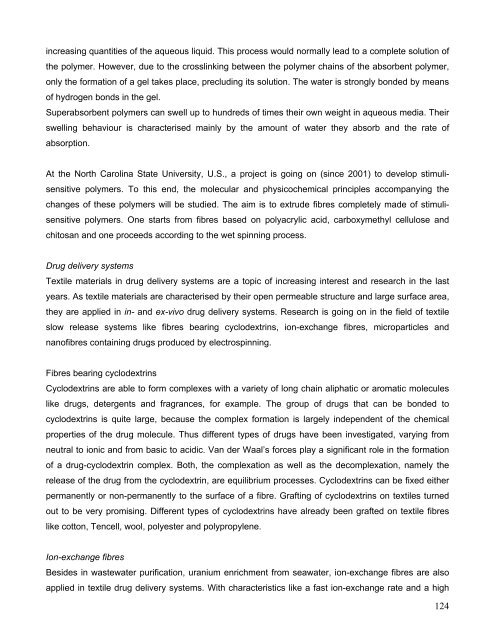Clevertex - Grado Zero Espace Srl
Clevertex - Grado Zero Espace Srl
Clevertex - Grado Zero Espace Srl
Create successful ePaper yourself
Turn your PDF publications into a flip-book with our unique Google optimized e-Paper software.
increasing quantities of the aqueous liquid. This process would normally lead to a complete solution of<br />
the polymer. However, due to the crosslinking between the polymer chains of the absorbent polymer,<br />
only the formation of a gel takes place, precluding its solution. The water is strongly bonded by means<br />
of hydrogen bonds in the gel.<br />
Superabsorbent polymers can swell up to hundreds of times their own weight in aqueous media. Their<br />
swelling behaviour is characterised mainly by the amount of water they absorb and the rate of<br />
absorption.<br />
At the North Carolina State University, U.S., a project is going on (since 2001) to develop stimulisensitive<br />
polymers. To this end, the molecular and physicochemical principles accompanying the<br />
changes of these polymers will be studied. The aim is to extrude fibres completely made of stimulisensitive<br />
polymers. One starts from fibres based on polyacrylic acid, carboxymethyl cellulose and<br />
chitosan and one proceeds according to the wet spinning process.<br />
Drug delivery systems<br />
Textile materials in drug delivery systems are a topic of increasing interest and research in the last<br />
years. As textile materials are characterised by their open permeable structure and large surface area,<br />
they are applied in in- and ex-vivo drug delivery systems. Research is going on in the field of textile<br />
slow release systems like fibres bearing cyclodextrins, ion-exchange fibres, microparticles and<br />
nanofibres containing drugs produced by electrospinning.<br />
Fibres bearing cyclodextrins<br />
Cyclodextrins are able to form complexes with a variety of long chain aliphatic or aromatic molecules<br />
like drugs, detergents and fragrances, for example. The group of drugs that can be bonded to<br />
cyclodextrins is quite large, because the complex formation is largely independent of the chemical<br />
properties of the drug molecule. Thus different types of drugs have been investigated, varying from<br />
neutral to ionic and from basic to acidic. Van der Waal’s forces play a significant role in the formation<br />
of a drug-cyclodextrin complex. Both, the complexation as well as the decomplexation, namely the<br />
release of the drug from the cyclodextrin, are equilibrium processes. Cyclodextrins can be fixed either<br />
permanently or non-permanently to the surface of a fibre. Grafting of cyclodextrins on textiles turned<br />
out to be very promising. Different types of cyclodextrins have already been grafted on textile fibres<br />
like cotton, Tencell, wool, polyester and polypropylene.<br />
Ion-exchange fibres<br />
Besides in wastewater purification, uranium enrichment from seawater, ion-exchange fibres are also<br />
applied in textile drug delivery systems. With characteristics like a fast ion-exchange rate and a high<br />
124

















